Hit the Road Again! Exploring Northeastern France
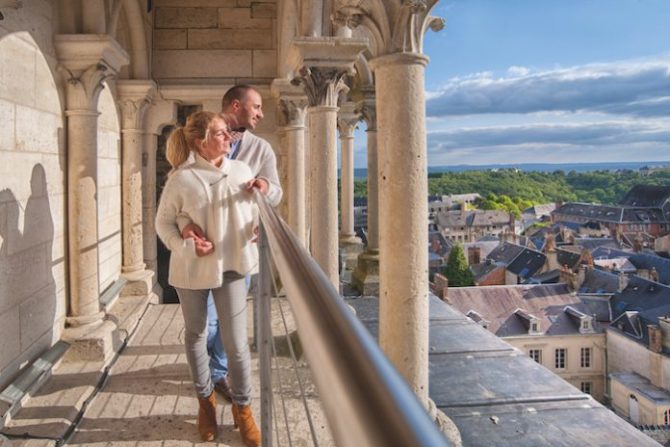
Eyeing a tour of northeastern France for your next visit? Why not explore the towns, villages, landscapes, museums and key war sites of the four départements of Meuse, Aisne, Somme and Pas-de-Calais – with one eye on history and the other on pure holiday pleasures: slow tourism, green escapes, city break ideas, fun activities, plus superb gastronomy and art and history galore.
The Magic of Meuse
Meuse is a true gem for lovers of the French countryside, and getting around by car is a delight – you are more likely to see a tractor than a car on most of the country roads.
As a starting point, the town of Bar-le-Duc is hard to beat. Providing a majestic step back to the 16th century, this quaint and quiet former capital of the Duchy of Bar has some of the most beautifully preserved Renaissance architecture in France. In its upper town, look up at the pediments and gargoyles peering down onto the rue des Ducs de Bar, then head to the stunning place Saint-Pierre to admire the Gothic style and Renaissance details of Saint-Étienne church.
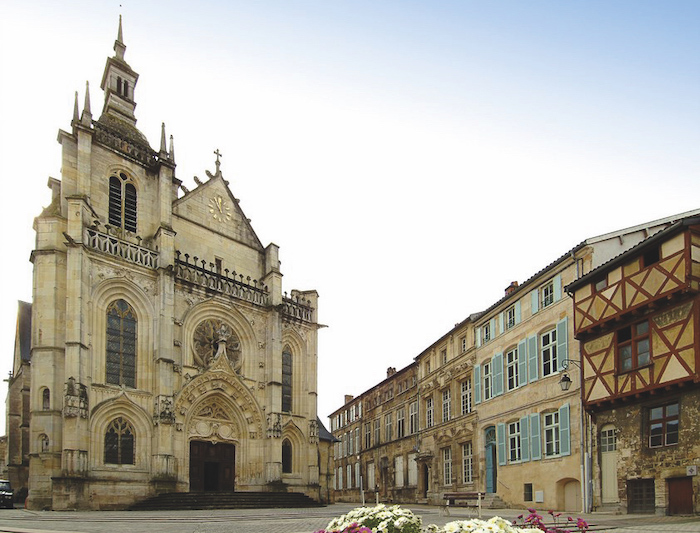
Place Bar-le-Duc Photo credit © Michel Petit
Produce-wise, the juicy, yellow mirabelle plum is an iconic fruit in Meuse and you can find it in umpteen guises – in desserts, jam, liqueur… while another fruity delight to sample in Bar-le-Duc is the luxurious confiture de groseilles, made lovingly by hand (the redcurrant seeds are removed using a goose feather!). This ‘fruit caviar’ was favoured by Alfred Hitchcock.
En route from Bar-le-Duc to Saint-Mihiel (about 35km), make a stop at Vent des Forêts, an outdoor contemporary art hub in the forest with trails of varying lengths.
Once in Saint-Mihiel, enjoy some spectacular Ligier Richier works, including The Entombment, a set of 13 characters cut in limestone blocks in Saint-Étienne church. Elsewhere, don’t miss the splendid former courthouse that now houses exhibitions, or the amazing Benedictine library upstairs in the former Abbey.
The town is also a handy base for outdoors pursuits – kayak along the Meuse river from here or at nearby Lake Madine, or ride a hired bike along the new EuroVelo 19 route.

The Meuse by bike. Photo credit © Marjolein Van Rotterdam- Coll. Grand Est Regional Tourism Agency
Remembrance in Meuse
Among the many, many important World War One remembrance sites and museums in Meuse, unmissable are the Meuse-Argonne American Cemetery; the battle-scarred hill at Butte de Vauquois; and the American Memorial in Varennes-en-Argonne.
Another must-see is the Romagne 14-18 museum, where Dutchman Jean-Paul de Vries has gathered an eclectic collection of war artefacts. Leaving Argonne and heading southeast, you reach the Verdun battlefield, scene of the longest battle of all, from February to December 1916. Visit the brilliantly-conceived Verdun Memorial museum, as well as Douaumont, where an epic-scale ossuary shelters the remains of 130,000 unknown French and German soldiers, and the mighty Fort de Douaumont. Finally, witness the sacrifice of French communities at one of nine ‘destroyed villages’.
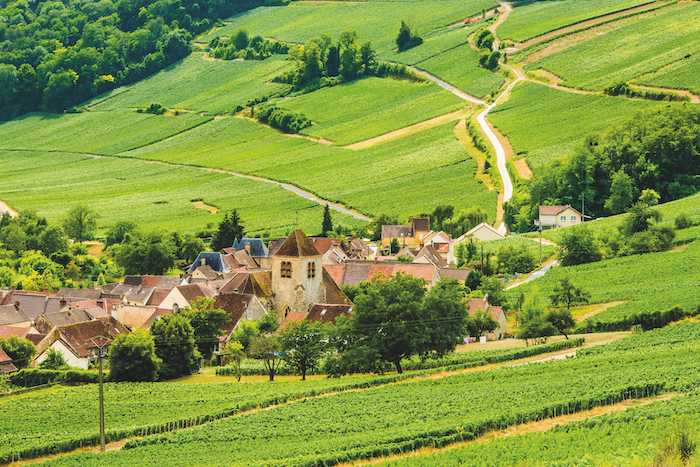
Panoramic countryside, Aisne. Photo credit © Cambon
A Sparkling Adventure in Aisne
Leaving Meuse and heading west, then north, on the A4/A26 you reach the historic town of Laon, one of the Aisne département’s showstoppers, and its capital.
Sitting majestically atop the Montagne Couronnée (Crowned Mountain) in wheatfield country with hilly landscapes, the eye-pleasing nook initially enjoyed great wealth thanks to its wine industry (ruined by phylloxera in the 19th century) and was also a garrison town, and capital of France during the Carolingian times.
Its skyline is dominated by the spectacular Notre-Dame Cathedral, completed in 1235 and one of the first primitive Gothic church buildings in the world. Its statues were renovated from 1854 to the start of World War One, when the cathedral served as a field hospital. Look out for stone depictions of oxen, whose efforts in lugging the limestone up the hill for the cathedral’s construction are honoured. Take a vertiginous tour of the cathedral’s upper reaches for a sense of the scale and history, and marvel at the town’s maze of underground passages, unique in France.
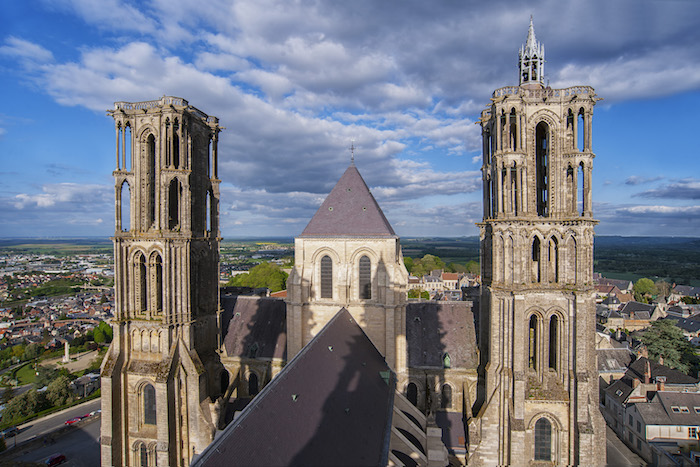
Cathedrale Laon. Photo credit © Horizon Bleu
Laon’s narrow, medieval streets are a joy to explore: seek out the Museum of Laon, used as a makeshift synagogue for German Army Jews during World War One, and beside it a rare Templars’ chapel. There are lovely boutiques to browse and restaurants to enjoy – try local Picardy speciality, ficelle picarde, a ham and mushroom pancake slathered in cheese.
Around 45km north of Laon is Saint-Quentin, whose resurrection following 80 per cent destruction during World War One (it was on the Hindenburg Line, and all of its occupants left in March 1917) is especially significant thanks to the abundance of Art Deco buildings that came to prominence during the 1920s.
Spot the blend of brightly-coloured edifices lining the main square: mixed in with Art Deco are Flemish- and Baroque-style façades. A look around the Hôtel de Ville (1509) is essential – the flamboyant Gothic exterior with 173 sculptures is impressive enough, and the regular chiming of the carillon bells is delightful. But most eye-catching is the Louis Guindez-designed Art Deco woodwork and ironwork in the room used for the Conseil Municipal meetings. It is truly magnificent. Saint-Quentin is a lively place with big-name shops, some great bars and lots of cultural spots to enjoy.

Enjoy a tasting at Champagne Météyer Photo credit © AisneTourisme-Mathieu Farc
Aisne is in Champagne country – it produces around 10 percent of all champagne – meaning visitors can explore its vineyards, villages and historic buildings as part of the Route Touristique du Champagne. So many producers, such as the Météyer family – open up their cellars for tours and a jolly sip. ring sessions. And visitors get a chance to buy a bottle or three, bien sûr.
And for a bit of fresh air and some relaxing country views, head out onto the Aisne’s section of the EV3 EuroVelo cycle route – safe and secure and perfect for a family jaunt on two wheels. The EV3 is not in Champagne country but at the north of the département in the Thiérache, beloved for its fortified churches, Godin’s social palace, meadows, and production of Maroilles cheese and cider.
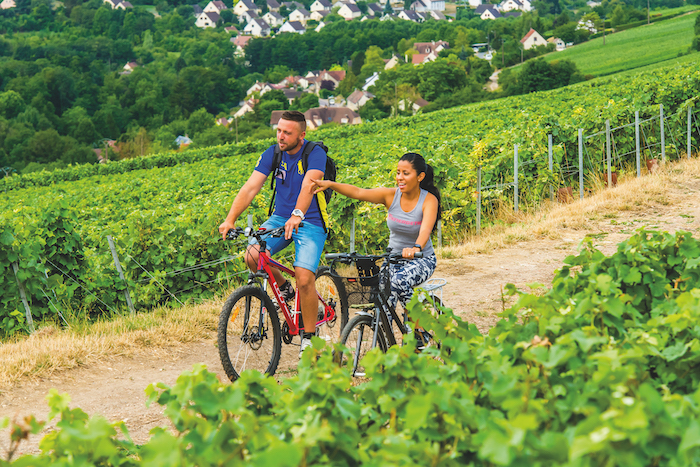
Cycling routes along Champagne vineyard in Aisne. Photo credit © Cambon
Aisne history is heavy with war stories. You can explore its role by planning visits to moving and fascinating sites like the Caverne du Dragon, an underground quarry that served as a barracks (for both French and German soldiers), plus three American cemeteries, Somme, Oise-Aisne and Aisne-Marne – the latter next to Belleau Wood, site of heavy losses in June 1918. Clockwise from above: Cathédrale Notre-Dame de Laon is just one of many draws for architecture buffs; enjoy a tasting at Champagne Meteyer; there is plenty to impress art-lovers; this part of France is ideal for exploring by bicycle.
Also unmissable for U.S. visitors is the new Interpretation Centre at Côte 204, near Château-Thierry. This small museum charts America’s involvement in the war. Finally, the Château de Blérancourt is a must-visit. It houses the Museum of Franco-American Cooperation and served as the headquarters of the American Committee for Devastated France, founded by Anne Morgan (daughter of financier JP Morgan), who helped rebuild the Aisne département post-war.
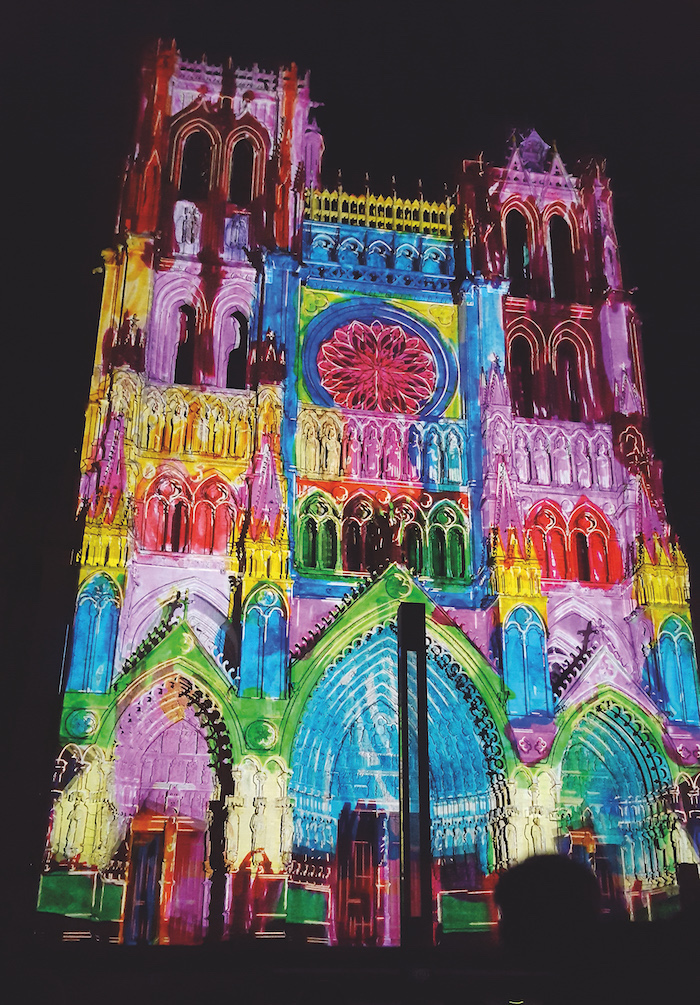
Amiens Cathedral is marking its 800th anniversary with a sound and light show. Photo credit © Amiens Metropole
Sample the Best of Somme
The capital of Somme is historic Amiens, and as a city-break destination it offers an exceptional range of attractive options: proximity to Paris (just an hour by train), historical intrigue and architectural appeal (a resplendent UNESCO-listed Gothic cathedral, Jules Verne’s house), a lively night-time ambience (the Saint-Leu district is totally buzzing, and pretty to boot), plenty for kids to do, plus many green spaces – including the famous water gardens, Les Hortillonnages. The city is also compact, giving it a village feel and ease of exploration.
The majestic cathedral, which underwent restoration in the 19th century, is 800 years old this year. When it was laser-cleaned in the 1990s, experts discovered that the western façade was originally painted in multiple colours – this sensory impression is now recreated at sundown during the summer, as well as at Christmas, via state-of-the-art sound and light displays. The cathedral’s 800th anniversary is being with festivities and a special son et lumière: Chroma. Next to the cathedral is a peaceful garden while beyond that is the picture-perfect rue de Metz – take a stroll down here at dusk and admire the wide array of building styles.
Down the hill is the Saint-Leu district. Abandoned until 35 years ago, this riverside quarter has been reborn and is a real hive of activity thanks to its bars and restaurants.
Not far from here, towards the Saint-Pierre quarter, is the surprising, unique 300-hectare network of canals on reclaimed marshland, called Les Hortillonnages. These ‘floating’ gardens have been exploited by market gardeners for over 800 years and today your barque trip around the maze of rieux (canals) reveals everything from fruit and veg for sale to an array of ever-changing art installations (thanks to the art & jardins – Hauts-de-France organisation).
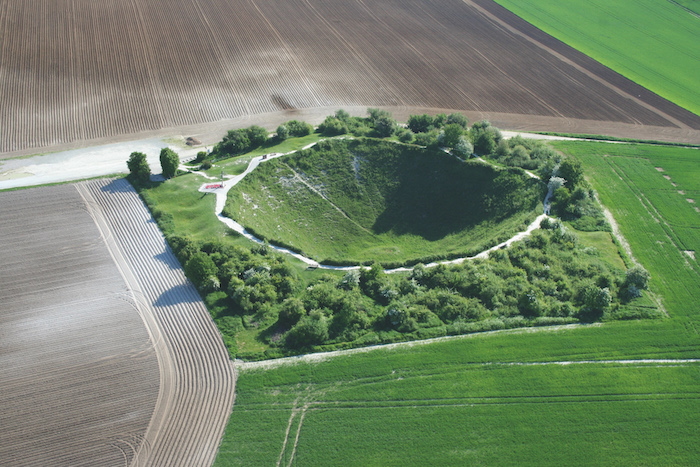
The Lochnagar crater, just south of the village of La Boisselle. Photo credit © Somme Tourisme-Garry
Somme Offensive: Lest we Forget
A major benefit of Amiens is that it serves as a base for exploring the many and varied Great War museums and memorials that mark the Somme Offensive, which took place between July 1 and November 18, 1916. You can make day trips around the département to pay your respects to those who died in one of the bloodiest battles in human history, calling upon the Somme Battlefields’ Partner network – 140 professionals who can advise on places to visit, accommodation and more to help you get the most from your experience, plus guides.
Our list of highlights includes the all-encompassing, expertly conceived Historial de la Grande Guerre in Péronne; the 21m deep Lochnagar crater (named La Grande Mine on road signs), 25km northwest of Péronne, at La Boisselle. It was formed when 27 tonnes of explosives were detonated by the British on July 1, 1916, after tunnelling under German lines.
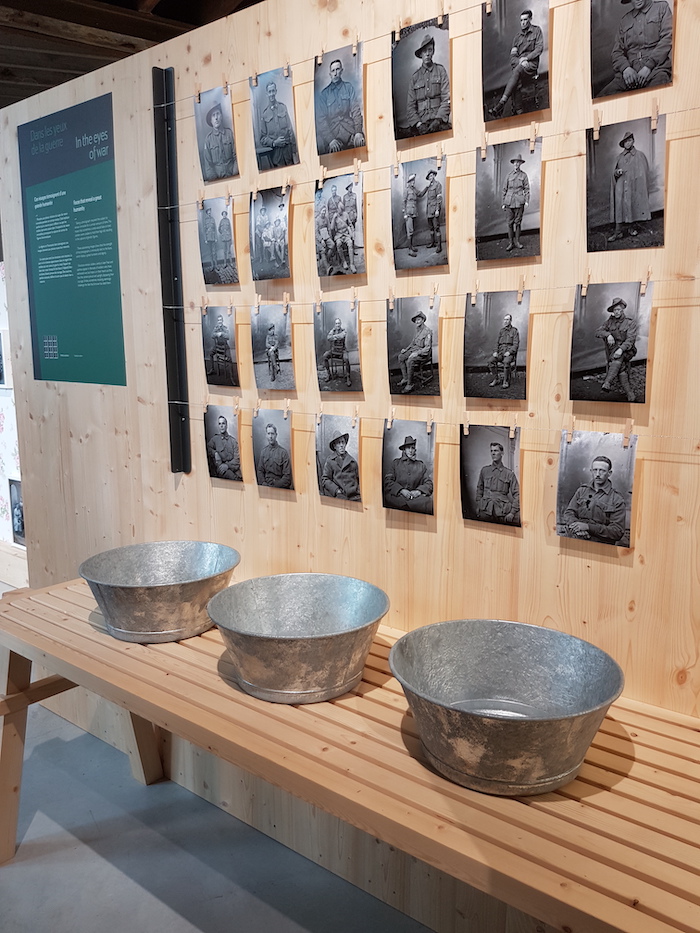
The Vignacourt 14-18 Interpretation Centre tells the story of life behind the lines. Photo Credit © CBojda
Along the Circuit du Souvenir (Remembrance Trail, symbolised by poppies on road signs) in Albert, visit the Somme 1916 Museum, which depicts life in the trenches via a collection of fascinating artefacts. Two Commonwealth sites nearby that demand attention are the Newfoundland Memorial at Beaumont-Hamel, which commemorates the Newfoundland Regiment’s sacrifices (86 per cent casualty rate), and the British Memorial (to the missing) and museum at Thiepval.
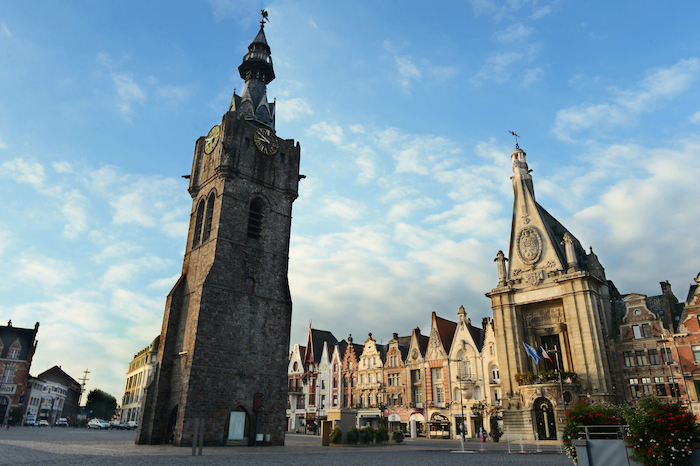
Beffroi de Béthune, Pas-de-Calais. Photo credit. © Yannick Cadart
An Artful Look at Pas-de-Calais
Béthune in the Pas-de-Calais département became something of a British town during the war due to a steady flow of Commonwealth soldiers passing through on leave and the regiments quartered there – follow the British Remembrance Trail around town to trace their story.
La Grand’Place was largely destroyed in the German offensive of 1918. Thankfully, its 14th-century belfry survived and to this day still dominates the square, which was rebuilt in the 1920s and is now home to some stunning examples of Art Deco style. There is a regional celebration of all things Art Deco every spring.
About half an hour from Béthune is Lens, firmly on the cultural map thanks to the art and history behemoth Louvre-Lens.
Louvre Paris lends it an evolving display of 200 exceptional items in the Galerie du Temps, masterpieces from 3,500 BC to the mid-19th century to be fully appreciated using the top-notch audiovisual guides in English. Major temporary exhibitions fill one of the other wings.
The glass museum was built on the site of a former mine and, while the industry is long gone, it still features heavily in the town’s identity. You can visit the highest mining slag heaps in Europe, and climb one for a sublime view if you have the energy!
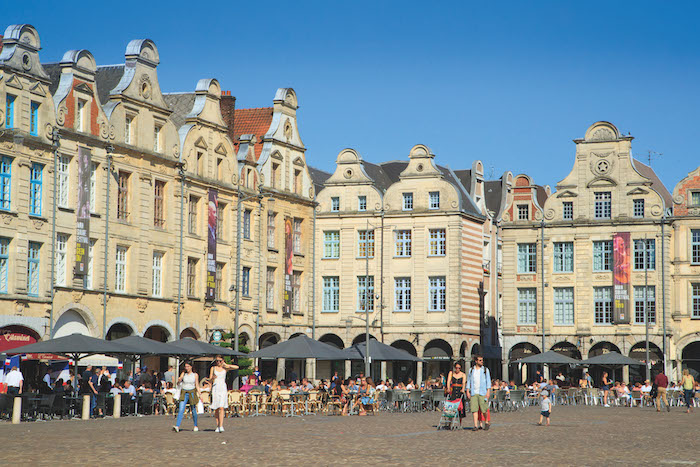
Place des Heros in Arras. Photo credit © Pas-de-Calais Tourisme
Twenty minutes from Lens is attractive Arras, whose landmark main squares, La Grand’Place and La Place des Héros, also called La Petite Place, are things of big-scale beauty.
Take the lift up the 75m high belfry that served as a watchtower, for spectacular views over the café-lined squares below – they are especially lively at weekends. Elsewhere, check out Vauban’s impressive 17th-century citadelle.
Round your visit off with a beer – brewing is big in these parts, and Chez Marcel is a fantastic place for craft ales and cheese pairings. And don’t forget that the Pas-de-Calais coastline, spreading from the Channel ports to the Baie de Somme, plus its expansive inland paysages, are worth exploring – ideal for better social distancing!
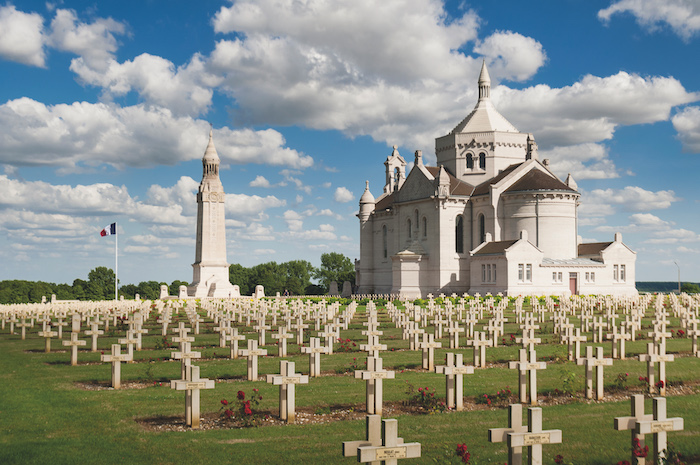
Notre Dame de Lorette and the moving site of the French cemetery. Photo credit © Pas-de-Calais Tourisme
Remembrance in Pas-de-Calais
One of the most iconic Remembrance monuments on the Western Front is at Vimy Ridge, near Lens. Set in sprawling parkland, it pays tribute to 11,285 Canadian Expeditionary Force soldiers reported missing. And a 15 minute drive away are three more vital Remembrance sites, in close proximity: in Souchez, the Memorial 14-18 is a four-room museum in black concrete and glass featuring annotated maps that reveal key movements and battles from the conflict.
Nearby at Notre-Dame de Lorette is a necropolis whose cemetery and ossuary hold the remains of more than 42,000 soldiers, while over the road the Ring of Remembrance pays homage – via engraved names – to 579,606 troops from all sides who perished in northern France.
In Arras stop at its remarkable Wellington Quarry, a museum that also serves as a memorial to those who died in the Battle of Arras. Don a hard hat and descend in a lift to experience life in the quarry through the eyes of those who sheltered in it before bravely entering the battlefield on April 9, 1917.
From France Today magazine

Carrière Wellington, Pas-de-Calais. Photo credit © M-Harmel
Share to: Facebook Twitter LinkedIn Email
Leave a reply
Your email address will not be published. Required fields are marked *



